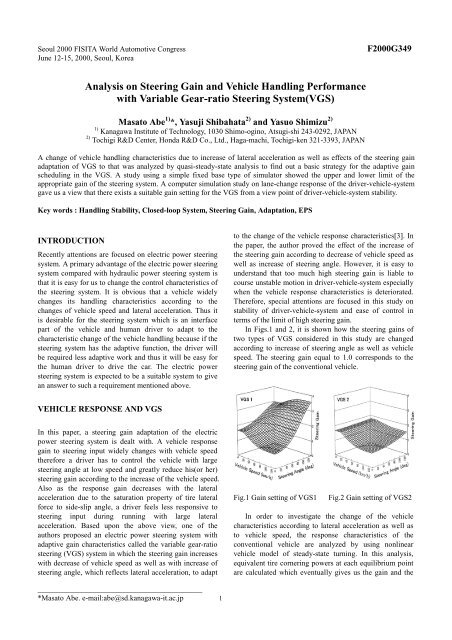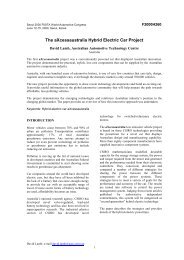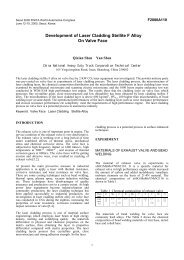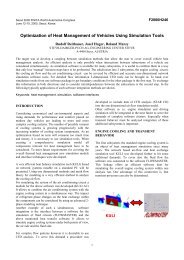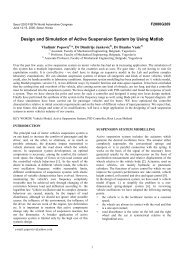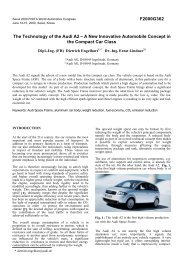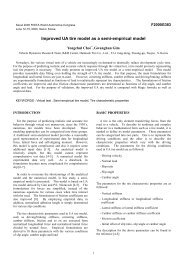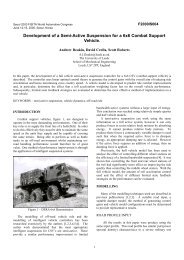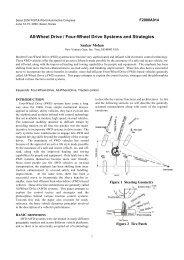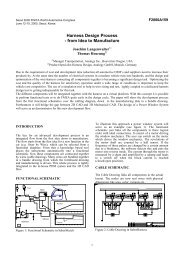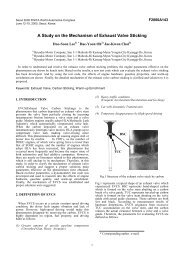Analysis on Steering Gain and Vehicle Handling Performance with ...
Analysis on Steering Gain and Vehicle Handling Performance with ...
Analysis on Steering Gain and Vehicle Handling Performance with ...
Create successful ePaper yourself
Turn your PDF publications into a flip-book with our unique Google optimized e-Paper software.
Seoul 2000 FISITA World Automotive C<strong>on</strong>gress<br />
June 12-15, 2000, Seoul, Korea<br />
F2000G349<br />
<str<strong>on</strong>g>Analysis</str<strong>on</strong>g> <strong>on</strong> <strong>Steering</strong> <strong>Gain</strong> <strong>and</strong> <strong>Vehicle</strong> H<strong>and</strong>ling <strong>Performance</strong><br />
<strong>with</strong> Variable Gear-ratio <strong>Steering</strong> System(VGS)<br />
Masato Abe 1) *, Yasuji Shibahata 2) <strong>and</strong> Yasuo Shimizu 2)<br />
1) Kanagawa Institute of Technology, 1030 Shimo-ogino, Atsugi-shi 243-0292, JAPAN<br />
2) Tochigi R&D Center, H<strong>on</strong>da R&D Co., Ltd., Haga-machi, Tochigi-ken 321-3393, JAPAN<br />
A change of vehicle h<strong>and</strong>ling characteristics due to increase of lateral accelerati<strong>on</strong> as well as effects of the steering gain<br />
adaptati<strong>on</strong> of VGS to that was analyzed by quasi-steady-state analysis to find out a basic strategy for the adaptive gain<br />
scheduling in the VGS. A study using a simple fixed base type of simulator showed the upper <strong>and</strong> lower limit of the<br />
appropriate gain of the steering system. A computer simulati<strong>on</strong> study <strong>on</strong> lane-change resp<strong>on</strong>se of the driver-vehicle-system<br />
gave us a view that there exists a suitable gain setting for the VGS from a view point of driver-vehicle-system stability.<br />
Key words : H<strong>and</strong>ling Stability, Closed-loop System, <strong>Steering</strong> <strong>Gain</strong>, Adaptati<strong>on</strong>, EPS<br />
INTRODUCTION<br />
Recently attenti<strong>on</strong>s are focused <strong>on</strong> electric power steering<br />
system. A primary advantage of the electric power steering<br />
system compared <strong>with</strong> hydraulic power steering system is<br />
that it is easy for us to change the c<strong>on</strong>trol characteristics of<br />
the steering system. It is obvious that a vehicle widely<br />
changes its h<strong>and</strong>ling characteristics according to the<br />
changes of vehicle speed <strong>and</strong> lateral accelerati<strong>on</strong>. Thus it<br />
is desirable for the steering system which is an interface<br />
part of the vehicle <strong>and</strong> human driver to adapt to the<br />
characteristic change of the vehicle h<strong>and</strong>ling because if the<br />
steering system has the adaptive functi<strong>on</strong>, the driver will<br />
be required less adaptive work <strong>and</strong> thus it will be easy for<br />
the human driver to drive the car. The electric power<br />
steering system is expected to be a suitable system to give<br />
an answer to such a requirement menti<strong>on</strong>ed above.<br />
to the change of the vehicle resp<strong>on</strong>se characteristics[3]. In<br />
the paper, the author proved the effect of the increase of<br />
the steering gain according to decrease of vehicle speed as<br />
well as increase of steering angle. However, it is easy to<br />
underst<strong>and</strong> that too much high steering gain is liable to<br />
course unstable moti<strong>on</strong> in driver-vehicle-system especially<br />
when the vehicle resp<strong>on</strong>se characteristics is deteriorated.<br />
Therefore, special attenti<strong>on</strong>s are focused in this study <strong>on</strong><br />
stability of driver-vehicle-system <strong>and</strong> ease of c<strong>on</strong>trol in<br />
terms of the limit of high steering gain.<br />
In Figs.1 <strong>and</strong> 2, it is shown how the steering gains of<br />
two types of VGS c<strong>on</strong>sidered in this study are changed<br />
according to increase of steering angle as well as vehicle<br />
speed. The steering gain equal to 1.0 corresp<strong>on</strong>ds to the<br />
steering gain of the c<strong>on</strong>venti<strong>on</strong>al vehicle.<br />
VEHICLE RESPONSE AND VGS<br />
In this paper, a steering gain adaptati<strong>on</strong> of the electric<br />
power steering system is dealt <strong>with</strong>. A vehicle resp<strong>on</strong>se<br />
gain to steering input widely changes <strong>with</strong> vehicle speed<br />
therefore a driver has to c<strong>on</strong>trol the vehicle <strong>with</strong> large<br />
steering angle at low speed <strong>and</strong> greatly reduce his(or her)<br />
steering gain according to the increase of the vehicle speed.<br />
Also as the resp<strong>on</strong>se gain decreases <strong>with</strong> the lateral<br />
accelerati<strong>on</strong> due to the saturati<strong>on</strong> property of tire lateral<br />
force to side-slip angle, a driver feels less resp<strong>on</strong>sive to<br />
steering input during running <strong>with</strong> large lateral<br />
accelerati<strong>on</strong>. Based up<strong>on</strong> the above view, <strong>on</strong>e of the<br />
authors proposed an electric power steering system <strong>with</strong><br />
adaptive gain characteristics called the variable gear-ratio<br />
steering (VGS) system in which the steering gain increases<br />
<strong>with</strong> decrease of vehicle speed as well as <strong>with</strong> increase of<br />
steering angle, which reflects lateral accelerati<strong>on</strong>, to adapt<br />
Fig.1 <strong>Gain</strong> setting of VGS1<br />
Fig.2 <strong>Gain</strong> setting of VGS2<br />
In order to investigate the change of the vehicle<br />
characteristics according to lateral accelerati<strong>on</strong> as well as<br />
to vehicle speed, the resp<strong>on</strong>se characteristics of the<br />
c<strong>on</strong>venti<strong>on</strong>al vehicle are analyzed by using n<strong>on</strong>linear<br />
vehicle model of steady-state turning. In this analysis,<br />
equivalent tire cornering powers at each equilibrium point<br />
are calculated which eventually gives us the gain <strong>and</strong> the<br />
___________________________________________<br />
*Masato Abe. e-mail:abe@sd.kanagawa-it.ac.jp 1
equivalent resp<strong>on</strong>se time of the vehicle resp<strong>on</strong>se to<br />
steering input at each running c<strong>on</strong>diti<strong>on</strong>.<br />
Fig.3 shows how the yaw rate gain <strong>and</strong> the time<br />
c<strong>on</strong>stant of yaw rate resp<strong>on</strong>se change <strong>with</strong> the increase of<br />
lateral accelerati<strong>on</strong>. Here the yaw rate resp<strong>on</strong>se is<br />
approximated by the 1 st order lag to steering input in<br />
which the time c<strong>on</strong>stant is given by the inverse of the<br />
natural frequency of the yaw rate resp<strong>on</strong>se. It is<br />
recommended that the optimum vehicle resp<strong>on</strong>se<br />
parameters – the yaw rate gain <strong>and</strong> the time c<strong>on</strong>stant –<br />
from the view point of ease of c<strong>on</strong>trol should exist at the<br />
particular regi<strong>on</strong> <strong>on</strong> the plane composed by the two<br />
parameters which is shown in Fig.4. The figure 5 shows<br />
the resp<strong>on</strong>se parameters of the c<strong>on</strong>venti<strong>on</strong>al vehicle <strong>on</strong> the<br />
plane.<br />
Fig.5 Resp<strong>on</strong>se parameters of c<strong>on</strong>venti<strong>on</strong>al vehicle<br />
Fig.3 <strong>Vehicle</strong> characteristics to lateral accelerati<strong>on</strong><br />
Fig.4 Optimum resp<strong>on</strong>se parameters by Wier[4]<br />
Also this analysis method is used for the evaluati<strong>on</strong> of<br />
the effect of the steering gain adaptati<strong>on</strong> by calculating the<br />
vehicle resp<strong>on</strong>se characteristics for the vehicle <strong>with</strong> the<br />
VGS. The results are shown in Figs.6 <strong>and</strong> 7. It is shown<br />
that the resp<strong>on</strong>se characteristics of the vehicle <strong>with</strong> VGS2<br />
remains <strong>with</strong>in the recommended regi<strong>on</strong> even during<br />
turning <strong>with</strong> braking, <strong>on</strong> the other h<strong>and</strong>, the vehicle<br />
resp<strong>on</strong>se parameters <strong>with</strong> VGS1 in some cases are fallen<br />
out of the regi<strong>on</strong> recommended as optimum. This results<br />
of the analysis gives us the basic strategy of the adaptive<br />
gain scheduling in the VGS to compensate for the<br />
Fig.6. Effects of VGS <strong>on</strong> vehicle resp<strong>on</strong>se characteristics<br />
resp<strong>on</strong>se characteristics change of the vehicle itself. The<br />
vehicle resp<strong>on</strong>se deteriorates at high lateral accelerati<strong>on</strong><br />
<strong>with</strong> high vehicle speed which is due to the excessive<br />
increase of the equivalent time c<strong>on</strong>stant. It suggests that<br />
there should be a limit in the intenti<strong>on</strong>al increase of the<br />
steering gain according to the steering angle to compensate<br />
for the decrease of the vehicle resp<strong>on</strong>se gain <strong>with</strong> the<br />
increase of the lateral accelerati<strong>on</strong>.<br />
2
polynomial of side-slip angle. Both of them are two degree<br />
of freedom vehicle plane model <strong>with</strong> c<strong>on</strong>stant speed.<br />
A task to follow r<strong>and</strong>om lane change comm<strong>and</strong>s<br />
during turning curved path <strong>with</strong> c<strong>on</strong>stant radius of<br />
curvature <strong>with</strong> c<strong>on</strong>stant speed as shown in Fig.9 is<br />
imposed up<strong>on</strong> the operator of the simulator. The vehicle<br />
previewed positi<strong>on</strong> <strong>and</strong> the target path is displayed <strong>on</strong> the<br />
screen. The time integral of square error between the<br />
vehicle previewed positi<strong>on</strong> <strong>and</strong> the target path is adopted<br />
as the performance index to evaluate the<br />
driver-vehicle-system.<br />
The results are shown in Fig.10. It is shown that the<br />
driver-vehicle-system performance is deteriorated <strong>with</strong><br />
increase of the lateral accelerati<strong>on</strong> during turning in which<br />
the lane change task is imposed <strong>on</strong> the driver. This is due<br />
to the deteriorati<strong>on</strong> of vehicle resp<strong>on</strong>se characteristics<br />
coursed by tire n<strong>on</strong>linear characteristics to side-slip angle.<br />
The performance is worse when the n<strong>on</strong>linear vehicle<br />
model is used for the simulator. This is because of<br />
unsymmetrical steering resp<strong>on</strong>ses between right <strong>and</strong> left<br />
directi<strong>on</strong>s at high lateral accelerati<strong>on</strong> in additi<strong>on</strong> to the<br />
deteriorati<strong>on</strong> of the resp<strong>on</strong>se characteristics itself.<br />
It is found that there exist upper <strong>and</strong> lower limits of the<br />
steering gain <strong>and</strong> the optimum range of it becomes narrow<br />
<strong>with</strong> the deteriorati<strong>on</strong> of the vehicle resp<strong>on</strong>se<br />
characteristics caused by lateral accelerati<strong>on</strong> during<br />
turning. This aspect is more clear especially in the results<br />
<strong>with</strong> the n<strong>on</strong>linear model <strong>and</strong> the upper limit of the<br />
steering gain is more sensitive to the deteriorati<strong>on</strong> of the<br />
vehicle resp<strong>on</strong>se characteristics.<br />
The above result suggests that there exists an upper<br />
limit of the steering gain for VGS as well from a view<br />
point of ease-of-c<strong>on</strong>trol for human driver especially during<br />
turning <strong>with</strong> high lateral accelerati<strong>on</strong> under which the<br />
vehicle resp<strong>on</strong>se characteristics deteriorates significantly.<br />
Taking this aspect into account, the optimum adjustment of<br />
the adaptive gain c<strong>on</strong>trol should be c<strong>on</strong>sidered in VGS.<br />
Fig.7 Characteristics during turning <strong>with</strong> 0.2G braking<br />
LIMIT OF STEERING GAIN<br />
For the purpose of proving general aspects of the effect of<br />
the steering gain <strong>on</strong> human drivers under the deteriorati<strong>on</strong><br />
of vehicle resp<strong>on</strong>se characteristics due to turning <strong>with</strong> high<br />
lateral accelerati<strong>on</strong>, the experimental study is c<strong>on</strong>ducted<br />
<strong>with</strong> a simple fixed base type of simulator as shown in<br />
Fig.8 for investigating typical c<strong>on</strong>trol characteristics of<br />
human operators. The resp<strong>on</strong>se characteristics of the<br />
simple simulator to the steering input is set as that of a<br />
vehicle turning al<strong>on</strong>g a circular path <strong>with</strong> c<strong>on</strong>stant lateral<br />
accelerati<strong>on</strong>. The two types of vehicle model are adopted.<br />
One is a linearized model at the trim point of the circular<br />
turning. Another is a n<strong>on</strong>linear <strong>on</strong>e using a n<strong>on</strong>linear tire<br />
model in which lateral force is described by sec<strong>on</strong>d order<br />
Fig.8 Fixed base type of simple simulator<br />
3
Fig.9 Lane change during circular turning<br />
<strong>with</strong> <strong>and</strong> <strong>with</strong>out VGS during circular turning <strong>with</strong><br />
c<strong>on</strong>stant lateral accelerati<strong>on</strong> is carried out. The computer<br />
simulati<strong>on</strong> model c<strong>on</strong>sists of 14 degrees of freedom<br />
vehicle n<strong>on</strong>linear model <strong>with</strong> combined slip type of tire<br />
model. The tire model is a brush type <strong>on</strong>e in which the<br />
combined lateral <strong>and</strong> l<strong>on</strong>gitudinal forces are obtained by<br />
integrating the distributed tire deformati<strong>on</strong>s in the<br />
c<strong>on</strong>tact-patch. A small size passenger cars equipped <strong>with</strong><br />
VGS1 <strong>and</strong> VGS2 respectively are c<strong>on</strong>sidered <strong>and</strong> the<br />
1 st -order preview model is adopted for a human driver in<br />
the simulati<strong>on</strong>.<br />
The simulated lane change resp<strong>on</strong>ses during circular<br />
turnings <strong>with</strong> lateral accelerati<strong>on</strong>s of 0.3G <strong>and</strong> 0.7G are<br />
shown in Figs.11 <strong>and</strong> 12. It is found that the vehicle<br />
resp<strong>on</strong>ses <strong>with</strong> VGS1 become oscillatory <strong>with</strong> the increase<br />
of the lateral accelerati<strong>on</strong> from 0.3G to 0.7G as is pointed<br />
out in the simulator study. However, the vehicle resp<strong>on</strong>ses<br />
<strong>with</strong> VGS2 still remains almost the same resp<strong>on</strong>ses as that<br />
of the c<strong>on</strong>venti<strong>on</strong>al vehicle even under circular turning<br />
<strong>with</strong> high lateral accelerati<strong>on</strong>.<br />
Fig.10 Results of simulator study<br />
COMPUTER SIMULATION<br />
In order to show the effects <strong>and</strong> the limit of the gain<br />
adjustment of VGS, a computer simulati<strong>on</strong> of the lane<br />
change resp<strong>on</strong>se of a closed-loop driver-vehicle-system<br />
Fig.11 Lane change resp<strong>on</strong>ses in turning <strong>with</strong> 0.3G lat.acc.<br />
The yaw rate resp<strong>on</strong>se of the vehicle <strong>with</strong> VGS1<br />
compared <strong>with</strong> the resp<strong>on</strong>se of the other vehicles in Fig.<br />
13 shows unsymmetrical aspect between the lane changes<br />
to inner <strong>and</strong> outer lanes especially during turning <strong>with</strong><br />
4
high lateral accelerati<strong>on</strong>. This also corresp<strong>on</strong>ds to <strong>on</strong>e of<br />
the results obtained in the former simulator study. On the<br />
other h<strong>and</strong>, there is no such aspect in the resp<strong>on</strong>se of the<br />
vehicle <strong>with</strong> VGS2, which suggests the view that the gain<br />
setting of VGS2 is <strong>with</strong>in a limit of the optimum steering<br />
gain discussed above.<br />
The experimental investigati<strong>on</strong> using a prototype<br />
vehicle <strong>with</strong> the VGS system proves the results obtained in<br />
the simulati<strong>on</strong> study menti<strong>on</strong>ed above.<br />
Fig.13 Lane changes to inner <strong>and</strong> outer lanes<br />
CONCLUSIONS<br />
The followings are summarized.<br />
Fig.12 Lane change resp<strong>on</strong>ses in turning <strong>with</strong> 0.7G lat.acc.<br />
(1) The vehicle resp<strong>on</strong>se parameters <strong>with</strong> <strong>and</strong> <strong>with</strong>out<br />
VGS depending <strong>on</strong> the lateral accelerati<strong>on</strong> during<br />
turning as well as <strong>on</strong> vehicle speed were calculated by<br />
using n<strong>on</strong>linear vehicle model of quasi-steady-state<br />
turning <strong>and</strong> it is shown that the resp<strong>on</strong>se<br />
characteristics of the vehicle <strong>with</strong> VGS2 remains<br />
<strong>with</strong>in the recommended regi<strong>on</strong>.<br />
(2) The simulator study shows that there exists upper <strong>and</strong><br />
lower limit of the vehicle steering gain <strong>and</strong> the range<br />
of the optimum gain becomes narrow <strong>with</strong> the<br />
deteriorati<strong>on</strong> of vehicle resp<strong>on</strong>se characteristics. The<br />
upper limit is more sensitive to the deteriorati<strong>on</strong>,<br />
5
which is due to the tire n<strong>on</strong>linear characteristics.<br />
(3) The computer simulati<strong>on</strong> study proves the results of<br />
the simulator study <strong>and</strong> shows that the gain setting of<br />
VGS2 is <strong>with</strong>in a limit of the optimum steering gain<br />
from the view point of stability <strong>and</strong> c<strong>on</strong>trol of<br />
driver-vehicle-system.<br />
(4) It is c<strong>on</strong>clusively found that the proposed electric<br />
power steering system <strong>with</strong> the adaptive steering gain<br />
characteristics is significantly effective for improving<br />
driver-vehicle-system performance<br />
ACKNOWLEDGEMENTS<br />
The authors are deeply indebted to Mr. Y. Kano,<br />
Kanagawa Institute of Technology <strong>and</strong> Mr. Y. Okada,<br />
Graduate Student of Kanagawa Institute of Technology for<br />
their cooperati<strong>on</strong> <strong>with</strong> the simulator study.<br />
REFERENCES<br />
[1] S. Takimoto et al. “A Study of Drivers Behavior in<br />
Turning a Curve” Proceedings of JSAE Spring<br />
C<strong>on</strong>venti<strong>on</strong> 9732748, 1997<br />
[2] J. Tajima et al. “Research <strong>on</strong> Effect of <strong>Steering</strong><br />
Characteristics <strong>on</strong> C<strong>on</strong>trol <strong>Performance</strong> of<br />
Driver-<strong>Vehicle</strong> System from a Viewpoint of<br />
Steer-by-Wire System Design” Proceedings of<br />
AVEC’98, Nagoya, September, 1998<br />
[3] Y. Shimizu et al. “Improvement in Driver-<strong>Vehicle</strong><br />
System <strong>Performance</strong> by Varying <strong>Steering</strong> <strong>Gain</strong> <strong>with</strong><br />
<strong>Vehicle</strong> Speed <strong>and</strong> <strong>Steering</strong> Angle : VGS(Variable<br />
Gear-ratio <strong>Steering</strong> System)” SAE Paper99PC-480,<br />
March, 1999<br />
[4] D.H.Wier et al. “Correlati<strong>on</strong> <strong>and</strong> Evaluati<strong>on</strong> of<br />
Driver-<strong>Vehicle</strong> Directi<strong>on</strong>al H<strong>and</strong>ling Data” SAE Paper<br />
780010<br />
6


